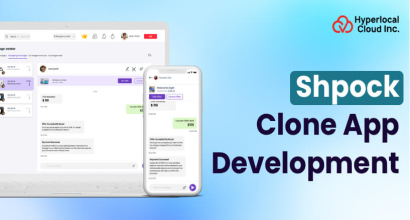The talent management industry is experiencing a radical shift as companies are realizing that their human resource is their sole competitive edge. Companies are not just sticking to old HR practices; they are moving towards advanced, technology-oriented systems that are more strategic for attracting, developing, and retaining the best talent.
In the modern business world, where companies must operate fast and efficiently, investing in an overall talent management solution is of great benefit in productivity, employee satisfaction, and overall business performance.
The talent management software business is growing at an impressive pace that is forecasted to reach $15.8 billion in the year 2030 with a CAGR of 12.4%. The growth of AI-based recruitment solutions, the necessity to manage a remote workforce, and the need to make decisions based on data drive this growth.
What Is A Talent Management System?
A talent management system (TMS) is a software solution that supports a company's practice in the entire employee lifecycle. The software basically manages recruitment, onboarding, performance management, learning and development, succession planning, and compensation processes. Implementing a TMS that centralizes employee data and automates HR processes is a powerful way for a company of any size to become a more effective workforce that can attract, develop, retain, and optimize talent while staying aligned with business goals.
Businesses or startups that are thinking of investing in a white label recruitment & staffing software or a talent management system, read below to understand how the system works, the benefits of investing in it, and how you can generate revenue through this software.
Build Your Branded Talent Platform in Days
How Does The Talent Management Software Work?
The following explains the way in which the talent management software operates:
1. Recruitment & Applicant Tracking
A system within the platform posts a single job publicly or multiplatform, and then it tracks candidates as they move through the various stages of hiring. Resume screening, interview scheduling, and communication with applicants are all done automatically by the system.
2. Onboarding
New employees are allowed to complete all required documents, training, and orientation digitally through the platform. The system takes care of distributing the tasks, following up on the progress, and ensuring that the rules of the company are respected.
3. Performance Management
Directors utilize the system to establish objectives, carry out evaluations, and offer ongoing feedback. The system keeps a record of employee accomplishments, qualifications, and performance issues over a long period.
4. Learning & Development
The system provides employee training, certification, and skill enhancement through various programs. It tracks each one's training progress and pinpoints the skill gaps in the organization.
5. Succession Planning
With the help of the software, the company can easily spot employees with high potential and get them ready for top management positions. By creating talent pipelines, the software ensures business continuity through the depiction of key positions.
6. Compensation Management
The tool is very effective in the management of salary reviews, bonuses, and benefits. Through it, pay structures remain fair, and the leading performers are kept motivated with the help of strategic rewards.
7. Analytics & Reporting
The system serves the platform in generating insights on workforce metrics, turnover rates, and talent trends. By doing so, it opens the way for HR to use data-driven decision-making in enhancing the organization's effectiveness.
Why Investing In A White Label Solution
White-label solutions offer a number of advantages for businesses looking to develop cost-effective talent management software. These are listed below:
| Benefits | Description |
| Cost-Effective | It is a ready-made solution and therefore does not require them to develop software, as it would reduce development expenses. |
| Ready-to-Use Solution | The software is already made and ready to use, with little setup needed. |
| Brand Customization | Put your company name and logo on it to make it look like your product. |
| Faster Market Entry | This product is pre-built, and it will save a lot of time in the development of the app for businesses, so that they can launch the app in a shorter period. |
| Ongoing Support & Updates | The businesses do not have to worry about maintenance, bug fixing, and feature additions, and the technical load is reduced. All of these are handled by the provider. |
| Scalability | The software is easily scalable as your business grows, without having to rebuild from scratch. |
Core Features Of An Effective Talent Management System
The following are the features of a talent management system that make it more efficient to use and simplify the process:
1. Applicant Tracking System (ATS)
The applicant tracking feature enables oversight and administration of job openings. It helps in monitoring the job seekers through the recruitment process, and automates resume screening and interviewing.
2. Employee Onboarding
Automates new employee administration, training, and orientation protocols to make the new employee integrate into the company easily.
3. Performance Management
The performance management feature allows users to set goals, provide ongoing feedback, and conduct performance reviews. It also helps in monitoring the performance of the employee and development requirements.
4. Learning Management System (LMS)
Offers training programs, certifications, and skill development programs with tracking of progress and certification.
5. Succession Planning
Recognizes potential workers and develops talent pools towards management-level and specialized needs in the company.
6. Compensation Management
Manages salary processing, bonus processing, benefits processing, and competitive and reasonable compensation systems.
7. Employee Self-Service Portal
Allows the employees to view their personal information, request leave, update their personal details, and view their payslips themselves.
8. Skills and Competency Tracking
Follows the skills, certifications, and competencies of employees to determine weaknesses and develop specific development programs.
9. Analytics and Reporting Dashboard
This feature helps users to check the live reporting related to the workforce metrics, turnover rates, performance trends, and ROI of talent initiatives.
10. Career Development Planning
It helps the employees by offering them individualized career advancement, mentorship, and development programs. This will help employees build their careers in the organization.
Request a Personalized Walkthrough of Our White Label Solution
Smart AI Features That Will Transform Talent Management Software
Below are the AI-based functionalities that a company may add to the talent management system:
1. Smart Recruitment & Candidate Matching
By scanning resumes and job descriptions, an AI tool is able to pair the most suitable candidates with the available positions automatically. After a mere glance by AI through all the applications, only a handful of top candidates are left for human attention; thus, the recruitment officers' time is saved greatly. Ideal applicants are filtered out, and hence, recruiters only get to see the best of the best in terms of skills and experience.
2. Predictive Performance Analytics
The system employs ML to forecast the employee performance pattern and to spot the workforce that will yield the best over time. Managers thus get enabled, via such insights, to derive actions and strategize on training, retention, and promotion with confidence even ahead of time.
3. Personalized Learning Recommendations
Using the support of AI, staff training becomes much simpler and more productive as a perfect-fit program is suggested for each employee through skill development, career goal-setting, and performance evaluation. Working with a custom-fit learning journey is exactly what the employee experience requires in order to see a natural progression of their role level.
4. Automated Chatbots for HR Support
The AI chatbots help employees by providing them with immediate feedback on their queries. These queries may be related to the company's policy, benefits, or personalized leave requests. The implementation of chatbot services in human resources software solutions has been a major factor in reducing staff workload, enabling workers to get quick and accurate replies at any time without queues or helpdesks.
5. Employee Sentiment Analysis
The system examines input, surveys, and communication patterns to estimate employee mood and involvement. It gives warnings to management about employee burnout, dissatisfaction, or retention risks that, at most, may be off track from their respective fields.
6. Bias-Free Hiring Decisions
AI gets rid of unconscious bias in recruitment by zeroing in on the skills, qualifications, and experience only. It facilitates diversity and makes the practice of candidate evaluation fair and equally open to everyone, irrespective of their background.
How Is The Talent Management System Developed?
The following are the steps that businesses should follow in order to develop an efficient talent management system:
1. Planning and Strategy
In this step, businesses need to understand their target market and the current market trends in order to build a talent management platform. They need to analyze the pain points of their audience and develop a system that is effective enough to fulfill their users' requirements.
2. UI & UX Design
Now, the team of designers will work on the design part of the software. They will design a flow using the wireframes and prototypes to develop an interactive user interface.
3. Development Phase
In this phase, the team of developers works on developing a strong backend. There are two ways to develop the software. One is a custom-based app solution that is developed from scratch and costs more and takes a lot of time to develop. Another one is a white-label solution, which is a ready-made solution. Businesses can launch the software quickly using this solution, and it also costs them less compared to a custom solution.
4. Tech Stack
| Category | Technologies |
| Frontend Development | React.js, Angular, Vue.js |
| Mobile Development | React Native, Flutter, Swift (iOS), Kotlin (Android) |
| Backend Development | Node.js, Python (Django/Flask), Ruby on Rails, Java |
| Database Management | MongoDB, PostgreSQL, MySQL, Redis |
| Cloud Infrastructure | AWS, Google Cloud, Microsoft Azure |
| API Integration | RESTful APIs, GraphQL |
| Push Notifications | Firebase Cloud Messaging, OneSignal |
| Payment Integration | Stripe, PayPal, RazorpayRetry |
5. Testing & QA
After the successful development of the software, the testers will test the app to check if it is performing well or not. They will find the bugs in the application and fix them.
6. Launch & Maintenance
The app is launched on different platforms, like the Google Play Store or the Apple App Store, after the testing is done. After this, the business needs to gather the reviews of the users in order to keep the software up to date.
Why Talent Management Is Worth the Investment
Given below are some of the best reasons that show why businesses or startups should invest in a talent management system:
1. Boost Employee Motivation
Talent management also provides employees with the feeling of purpose and significant work, not only because of the salary. Research indicates that 91% of workers desire something beyond money to be genuinely motivated and focused at work.
2. Attract and Recruit Top Talent
An effective talent management system assists in creating a positive reputation for your company as a good workplace. This automatically brings talented employees who desire to work and make your organization successful.
3. Ensure Consistent Coverage for Critical Roles
It also ensures that the key positions are never left vacant, as it trains employees to take up key positions when the need arises. This will avoid any work overload to the current employees and will ensure the business activities continue without interruptions.
4. Enhance Employee Performance
Recruiting the right individuals early on will reduce performance problems and conflicts at the workplace in the future. It is also helpful to retain your top employees as they are pleased and willing to work longer with the firm.
5. Foster Employee Engagement
Employees are valued when they are accorded equal opportunities to train and advance their careers, and thus, they would be more interested in their employment. This will result in saving on the staffing and maintenance of your team, which is qualified and ready to do the business requirements.
6. Retain High-Performing Talent
Proper onboarding and development programs increase the chances of employees remaining in your company in the long run by 69%. This saves the recurrent cost and the burden of hiring and training new individuals.
7. Drive Overall Business Performance
Employees who are engaged, motivated, and skilled work harder to attain the goals of the company and provide superior performance. This is a direct result of satisfied clients, growth of revenue, and the business in general.
8. Achieve Higher Client Satisfaction
A well-planned talent management strategy improves teamwork and interaction within all your departments. Properly coordinated teams attend to clients in a shorter period of time and provide them with greater satisfaction and loyalty.
Talk to an Expert About Customizing Your Talent Management System
Challenges And Key Factors To Consider In Talent Management Systems
Below are some of the challenges encountered by businesses or startups, and how businesses should consider avoiding these challenges.
| Challenge | Description | Consideration |
| High Initial Cost
| Small-scale companies may find it difficult to purchase and install the system. | Compare price strategies and select scaled-up options that suit your budget. |
| Employee Resistance | Employees might be opposed to new technology, and they want to use the old way of doing things | Provide benefits in clear ways and engage employees in the process of transition as early as possible. |
| Complex Setup | Making and setting up the system is time-consuming and requires technical expertise. | Implementation of the plan in stages and receive assistance from the vendor or the IT team |
| Data Security Risks | Sensitive information concerning employees should be stored with a high level of security to avoid breaches of data. | Select vendors that are highly encrypted, comply, and have periodic security reviews. |
| Integration Issues | The integration of the system and current HR tools and software may be challenging. | Ensure that the vendor is compatible with the current systems and that he or she has integration support. |
| Training Required | Managers and employees should be trained to make good use of the system. | Offer regular training programs and prepare user manuals that are easy to understand for every employee. |
| Customization Needs | The program might not require modifications to fit the peculiarities of your company. | Consider personalization options prior to the purchase and provide the flexibility of changes in the future. |
Businesses That Can Benefit From Investing In Talent Management Software
Below are the businesses that can invest in the talent management software:
1. Large Enterprises & Corporations
Those companies that employ thousands of people require TMS to execute complex workforce practices. It assists in streamlining the HR operations in various departments, locations, and regions around the world.
2. Mid-Sized Growing Companies
Companies that are growing at a high rate will need to have an effective talent management in place to be able to scale their employees. TMS will enable them to manage recruitment, training, and performance monitoring during the growth.
Let’s Build Your Branded Platform Together
Key Revenue Drivers In The Talent Management Software Industry
The following are the sources using which businesses or startups can generate revenue from their talent management system:
1. Subscription-Based Model (SaaS)
The companies can charge monthly or yearly subscription fees depending on the number of users or employees who are using the platform. This is a recurring revenue model where the business can predict its earnings and scale the prices based on the increased client numbers.
2. Tiered Pricing Plans
The software vendors provide varying levels of packages (basic, professional, enterprise) at varying prices, including different features and capabilities. Clients are free to opt for the plans that suit them best and their budget, with the plan being upgraded anytime the need arises.
3. Per-User/Per-Employee Licensing
The revenue is collected based on the changes in individual users or employees using the system. The model of this type of flexible pricing will automatically scale with the size of the workforce of client and will make sure that organizations of any size can be fairly priced.
4. Premium Support and Maintenance
Extra fees for priority customer services, account managers, and a quicker process of addressing technical challenges. This will provide customers with the quickest possible assistance and little unproductivity in case of urgent procedures.
5. Add-On Modules and Features
Offering extra functionality such as advanced analytics, AI-driven applications, mobile apps, or special modules as an upsell. The ability to enlarge the systems without changing to completely different platforms can be provided to clients.
6. White Label Licensing
Selling the software to other firms that rebrand and then sell the software as theirs to their clients. This generates bulk revenue among partners and also enlarges the market without incurring direct sales.
7. Data Analytics and Reporting Tools
Billing of advanced analytics dashboards, custom reporting, and business intelligence that offers insight into the workforce is provided to a greater degree. These tools are of high quality and can assist organizations in making superior decisions concerning their talent based on facts and figures.
Wrapping Up!
Investing in a talent management system will help businesses introduce a virtual system that enables HR to manage talent and for employees to benefit from its features. To develop, one businesses need to partner with someone who is trusted and has years of experience in software development.
We at Hyperlocal Cloud have a team of developers who are skilled to develop scalable and interactive apps. With several years of experience, we stand tall as the best software development company and have helped build a talent management software for small businesses. Partnering with us to create a TMS software will cost you around $8,000. This is just an estimated cost. To know more, you can reach out to us today!



